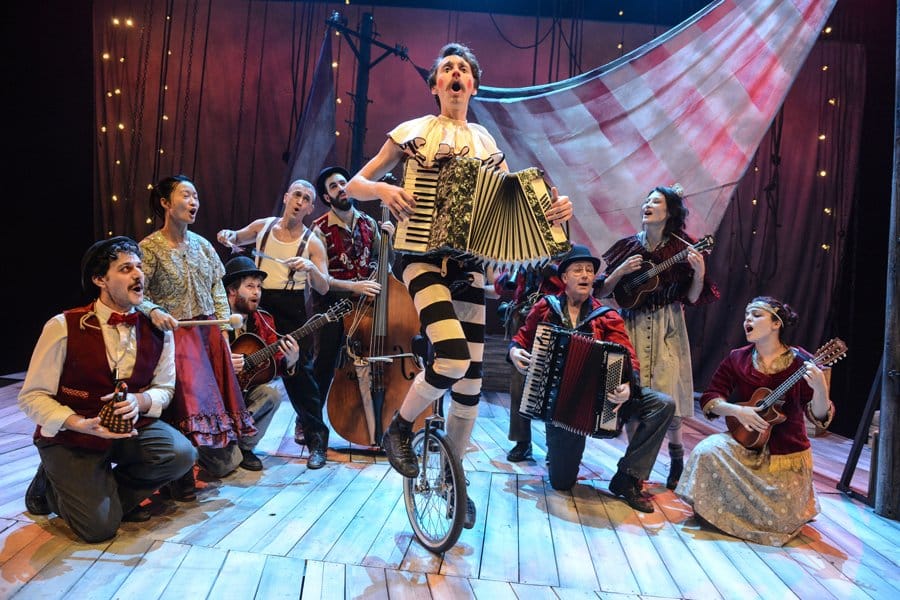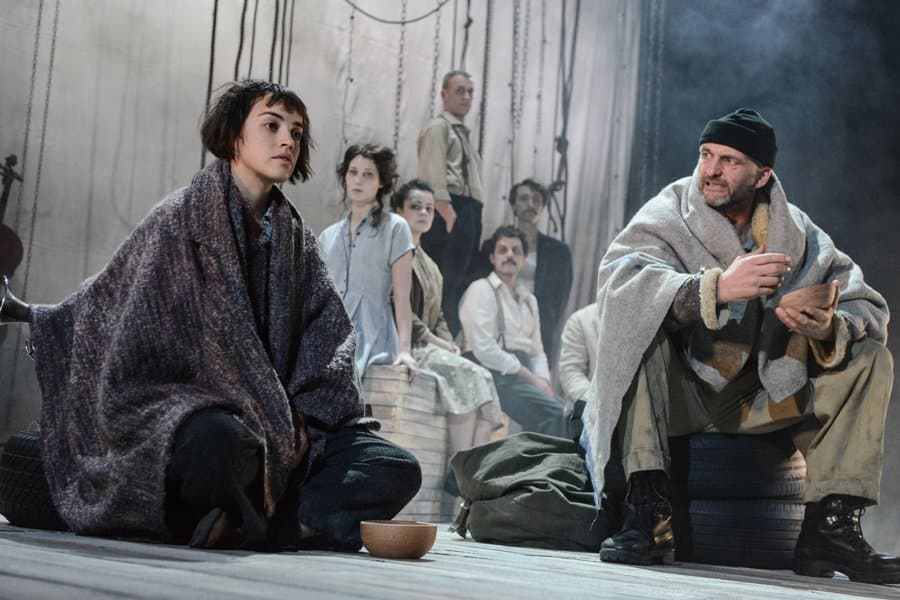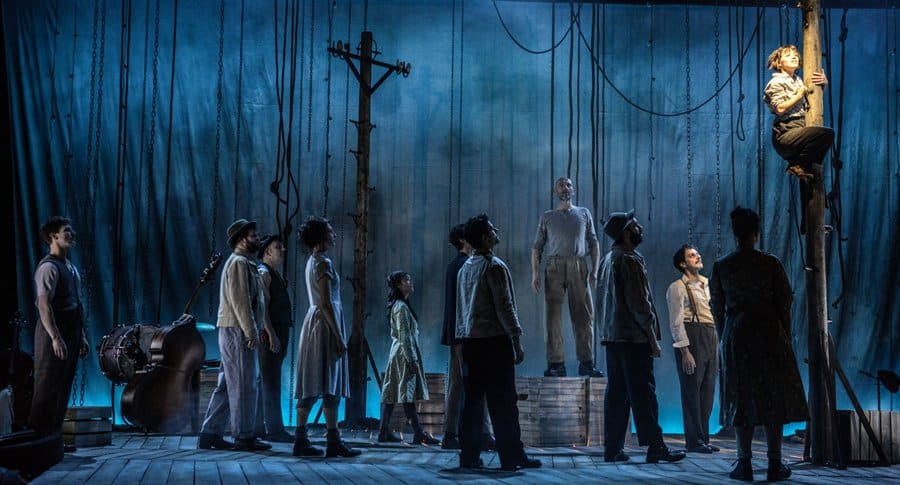
La Strada
The Other Palace
31st May 2017
3 Stars
Well, here’s a very jolly, entertaining piece of well executed director’s theatre: fascinating deviser Sally Cookson, in collaboration with writer Mike Akers, composer-lyricist Benji Bower, designer Katie Sykes, lighting designer Aideen Malone, sound designer Mike Beer and movement director Cameron Carver, have fashioned a brave attempt to put Federico Fellini’s brilliant Neo-Realist film, ‘La Strada’, onto the stage. A wonderful cast of 13 actor-musicians transports us into their marvellously pleasant interpretation of the movie. It is another bold creation brought to us by the restlessly creative producer Kenny Wax, working in association with Cambridge Arts, Bristol Old Vic and the Belgrade Theatre, Coventry. And last night, at The Other Palace, its premiere drew luminaries aplenty, including Anthony Drewe, Howard Goodall, Charles Hart, as well as Fellini’s niece and many more industry figures, making the foyer every bit as glamorous and entertaining as what was happening on stage.

Neo-Realism seems to be enjoying something of a vogue at the moment. First, we get Ivo van Hove’s staging of Luchino Visconti’s ‘Ossessione’, and now this, Fellini’s stark 1954 drama of outsiders, poverty, passion and despair. The Neo-Realist school of cinema was a movement that took itself very seriously, being led by academic theorists who then sometimes turned themselves into moviemakers. This drive to turn their filmic creations into stage-worthy productions might seem a little strange, given the tough intellectual intentions of the filmmakers who sought to create works which could not possibly be presented in any manner other than on the screen. One wonders – just wonders – what the thinking might be that lies behind this attempt to subvert their deep, profound, heart-felt mission?
Is it, possibly, that there is in the zeitgeist a certain identification with the underlying themes of that era: Italy is represented as a harsh world, ruled by brutes, in which the sensitive and vulnerable are doomed to destruction. Here, Fellini created his own screenplay, with regular long-term collaborators Pinelli and Flaiano. Into it, he poured his soul, and created in his own words, ‘a complete catalogue of my entire mythological world, a dangerous representation of my identity that was undertaken with no precedent whatsoever’. It is a bold and ambitious act to take this up as a project and hope to turn it into something of comparable stature.

When Fellini died, some years ago, there was a flurry of adoration, particularly in Italy, where television studios put together affectionate tributes, often drawing upon nostalgic affection for his most symbolic film, this story of the travelling strongman act and his tragic, bonded lackey. What was shown then, in those tributes, resembled very markedly what can now be seen on the main stage of The Other Palace in Westminster. It was very well performed, beautifully lit and tastefully staged; but it departed, in almost every important respect, from the work of one of the greatest artists of the twentieth century. And it is not difficult to sympathise with the reasons why this was so.
Fellini knew he had a herculean struggle on his hands to bring this very personal essay to fruition. He cast not only his wife and muse, Giullietta Masima, as the girl but took on a great big Hollywood star to play robustly against type in the deeply unsympathetic role of the motorcycling, philandering, drunkard muscleman, a kind of Peter Grimes on wheels who comes out on top: Anthony Quinn. With these massive personalities dominating proceedings, the stark, harsh, extreme chiaroscuro epic of the monochrome film is made to take on the power of Gogol’s ‘The Lower Depths’ in its agonising progress through impoverished post-war Italy. With the camera staying very close to the central characters, observing the slightest details of their brief, tawdry life together, we always feel we are wrapped up inside their world. And the effect is devastating.

That simply doesn’t work on the stage. But just as the Gogol story mentioned has been made to function beautifully well as a film, as well as equally successfully – but in a wholly different way – on the stage, there is no essential reason why ‘La Strada’ should not be capable of adaptation to theatrical presentation. If the circumstances are right.
Cookson has assembled a fascinating group of performers for her ensemble, and she has devised the work with them. It fits them like a glove. Carver’s movement, in particular, is often magical and lovely, and Bower’s musical arrangements are precisely matched to the cast’s many talents. The comparison of musical styles, however, may be instructive. Fellini took on one of the greatest film music composers of all time, Nino Rota, to create a score for his movie that borrows from the great verismo soundtracks of Italian opera, filtered through Chaplin’s own music for his tramp movies, and got a sound world that combines poetic sensibility with epic grandeur. The signature, clarion ‘dying fall’ of the key trumpet motif – a core feature of the drama – is one of the most unforgettable tunes in film scoring. Here, on the other hand, the music is smooth, gentle, calm and soothing: a kind of ‘Cafe del Fellini’ soundscape that irons out the pain and passion of the original, giving us a kinder, more reassuring vision. It pleases, but it does not thrill. At one point, we do get a blast of Verdi’s Requiem, and the emotional temperature rises; but it is only a moment, and it passes. Potentially, had the musical scoring taken that very different direction, we might have got a show that had a very different sort of impact.
The same can be said for the casting. This is a fine chorus ensemble that does everything required of it. But it does not contain the great stand-out performances that distinguished the film. So, all in all, it’s a finely done exercise, with some charm. Cookson may well go on to do something more powerful next time. I’ll look forward to seeing that very much.
Photos: Robert Day
